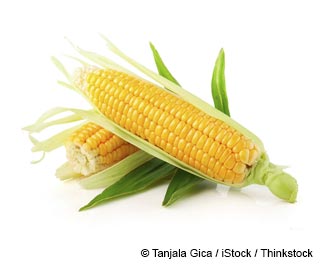Extraordinary Corn
Botanical name: Zea mays var. saccharata

Experts believe that corn originated in Mexico1 and was possibly transported northward by both indigenous people2 and European explorers.3 When pilgrims came to the Americas, the Native Americans they encountered introduced and taught them how to grow corn, considered to be a main crop.4
The Spruce highlights that you can grow corn in your backyard, and you’ll know it’s ready for harvest once the silk at the tip of the cob browns, the kernels are tender and milky, and the husks are firm with a dark green hue.5
Corn is available in various colors, such as white, yellow,6 purple,7 red, blue and even black.8 Its culinary options are endless, whether boiled on the cob,9 popped10 or added to salads11 and soups.12
Sweet corn is a favorite summertime snack,13 and if it’s dried it may be utilized to decorate wreaths and centerpieces once fall arrives.14 In some areas, cornhusks are used to wrap tamales, a well-loved food in Central and South America.15
Can You Get Health Benefits From Corn?
Corn contains flavonoids, which may aid in protecting the body against lung16 and oral cancers.17 Carotenoids such as beta-carotene, zeaxanthin and lutein18 may help maintain healthy skin19 and vision.20,21 Corn is also home to some amounts of potassium, phosphorus and vitamins A,22 E and K.23
While it’s generally thought that heating food diminishes its nutrients, a 2002 study published in the Journal of Agricultural and Food Chemistry showed that corn that underwent thermal processing at 115 degrees Fahrenheit for 25 minutes had:24
-
44% higher antioxidant activity
-
550% higher ferulic acid (FA) content. FA is a plant chemical that may promote antioxidant, anti-inflammatory and antiaging abilities, help scavenge harmful free radicals and protect your liver, lungs and brain.25
-
54% increased total phenolic quantity. Phenolics are antioxidants that help protect your body from oxidative damage, which may affect your DNA, lipids and proteins, and lower your risk for cancer and cardiovascular disease.26
However, the authors also discovered that corn’s vitamin C content decreased by 25% after processing.27 Aside from this, there are other reasons why you should consider eating corn in moderation. It contains some quantities of sugar28 that may be detrimental for your well-being, raising your risk for health problems like insulin resistance if eaten excessively.
An Environmental Working Group (EWG) article also highlighted that field corn grown in the U.S. is genetically engineered or modified. Even if test results showed that some corn crops didn’t contain traces of pesticides, these substances may still pose a risk to your health no matter the circumstance.29 If possible, try growing organic corn at home30 or look for corn that hasn’t been sprayed with herbicides, pesticides or other chemicals, and hasn’t been grown from genetically modified varieties.
Corn Nutrition Facts
Serving Size: 3.5 ounces (100 grams), sweet, yellow, cooked, boiled, drained, without salt31
| Calories |
125 |
|
| Calories from Fat |
|
|
| Total Fat |
1.96 g |
|
| Saturated Fat |
0.47 g |
|
| Trans Fat |
0 g |
|
| Cholesterol |
0 mg |
|
| Sodium |
22 mg |
|
| Total Carbohydrates |
27.11 g |
|
| Dietary Fiber |
2.9 g |
|
| Sugar |
9.08 g |
|
| Protein |
4.74 g |
|
| Calcium 3 mg |
Iron |
0.75 mg |
Studies Regarding Corn
Consuming foods with high amounts of calories, sweeteners and genetically engineered refined flour can increase your risk for obesity-linked diabetes and high blood pressure. In a 2007 Journal of Medicinal Food study, researchers assessed whether substances found in pumpkin, beans and corn (maize) may have potential in lowering the risk for these health problems among people living in indigenous North American communities.
Results showed that combinations of the selected plant foods, which tend to contain phenolic antioxidants, may assist reducing the risk for high blood sugar levels and lower the risk of side effects linked to high blood pressure. Out of the three foods tested, pumpkin exhibited the greatest potential.32
In another study, subjects consumed extra 12 grams of fiber derived from maize or tapioca per day. Researchers concluded that including this additional fiber in the diet was well-tolerated and may lead to benefits to gut and colon health because of dietary fiber’s potential in promoting a beneficial fermentation process inside the body.33
Corn’s potential benefits aren’t just limited to conventional yellow varieties. Authors of a 2019 Food Chemistry study discovered that extracts derived from purple corn contained high amounts of anthocyanins, phenolic acids and quercetin. All of them may contribute to purple corn’s potential in delivering anti-inflammatory, anti-diabetic and anti-adipogenic properties.34
Corn Fun Facts
Researchers found remains of maize kernels, cobs and leaves in dry mountain caves in Mexico. They also conducted further testing on sediments that may contain phytoliths or microfossils of maize varieties. Their results not only showed evidence of domesticated maize varieties, but also pointed to agricultural activity in the Yucatan Peninsula nearly 7,000 years ago.35
Summary
A well-loved crop mainly produced in the U.S., China and Brazil,36 corn is used for culinary37,38,39,40 and decorative41 purposes, and is home to vitamins and nutrients like vitamins A,42 E and K,43 alongside valuable substances like flavonoids and carotenoids.44 One study even showed that fiber made from corn enhanced gut and colon health.45
However, while these health benefits are certainly notable, don’t forget to consume corn, especially yellow sweet corn, in moderation asit still contains some quantities of sugar.46 Lastly, make sure that the corn you’re buying is organic, as most of the corn grown In the U.S. today is genetically modified.